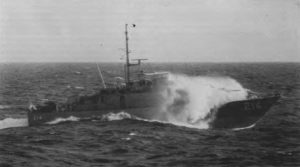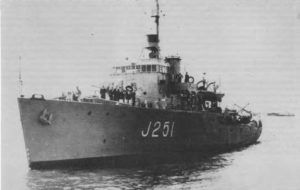- Author
- Rankin, A.G., Lt Cdr, RAN
- Subjects
- Ship design and development, Ship histories and stories
- Tags
-
- RAN Ships
- HMAS Colac, HMAS Swan II, HMAS Dubbo I, HMAS Dubbo II, HMAS Wallaroo, HMAS Waterhen (Base)
- Publication
- December 1994 edition of the Naval Historical Review (all rights reserved)
The Fremantle Class Patrol Boat HMAS DUBBO is celebrating her 10th Anniversary of Commissioning during 1994. As part of this special anniversary year, the ship’s company of the Darwin based patrol boat travelled to the City of Dubbo in NSW in March to exercise the privilege of Freedom of Entry. On this occasion they met members of the crew from the original HMAS DUBBO, a Bathurst Class Corvette, which served with honours in the Royal Australian Navy (RAN) between 1942 and 1946.
THE PRESENT

Photo: John Mortimer
The present day HMAS DUBBO is the twelfth of 15 “Fremantle” Class Patrol Boats and was built by the North Queensland Engineer and Agents Pty Ltd (NQEA) in Cairns, with a ship’s side pennant number of 214. She was launched on 21 January 1964 by Mrs Jenny Rourke, the wife of Rear Admiral W .J. Rourke, who was serving as the Chief of Naval Materiel at that time.
On completion of sea trials the ship was accepted into service and was commissioned at Cairns on 10 March 1984, under the command of Lieutenant Commander Mike Skopal, RAN. Alderman T.A. Slattery, Mayor of Dubbo, represented the City at the commissioning. From then until January 1986, DUBBO was based in Cairns carrying out surveillance duties in North Australian and South-West Pacific waters.
The ship then joined the Sydney Patrol Boat Squadron based at HMAS WATERHEN and took up surveillance duties in Australia’s southern waters, including Bass Strait oil rig patrols. In 1987 HMAS DUBBO participated in the Australian Government’s response to the Fijian coup and was sailed with other RAN Fleet units to support the evacuation of Australian and New Zealand nationals from Fiji, had the necessity arisen.
In October 1988, the ship was again relocated to her present home base at Darwin where she has been active in preventing incursions of errant foreign fishing vessels and illegal immigrants into the Australian Fisheries Zone and mainland north west Australia over the past five-and-a-half years.
Currently under the command of Lieutenant Commander Allan Rankin, HMAS DUBBO has the primary peacetime role of conducting fisheries patrols and surveillance duties across the Top End of Australia, from Port Headland in the west to Thursday Island in the east. The ship is also tasked with assisting other agencies such as Customs, Coastwatch and NORFORCE, and regularly participates in major naval exercises in the North Australia Area. In addition, DUBBO may be called upon to conduct goodwill visits to foreign ports in south east Asia or the south west Pacific. During 1994 these visits have included deployments to Indonesia, Papua New Guinea and the Philippines.
THE PAST

The first ship to bear the name of HMAS DUBBO had a ship’s side pennant number of J251 and was one of sixty “Bathurst” Class Corvettes built in Australian shipyards as part of the Commonwealth Government’s wartime shipbuilding programme. Twenty Corvettes were built on Admiralty order, but were commissioned and manned by the RAN. Thirty-six of the Class, including DUBBO, were built specifically for the RAN, and four were built for the Royal Indian Navy.
Built by Morts Dock and Engineering Company at Balmain in Sydney, the launching of HMAS DUBBO was attended by the Mayor of Dubbo City, Alderman E.B. Serisier. The ship was first commissioned on 13 July 1942 under the command of Lieutenant Arthur G. Thomas, RANR(S) and commenced her operational career attached to the RAN Escort and Anti-submarine Group based at Fremantle in West Australia.
DUBBO remained on this duty for a period of two-and-a half years during which she steamed over 77,000 nautical miles on routine patrols and escort work. In June 1943, while under the command of Lieutenant Norman Weber, RANR(S), DUBBO went to the rescue of her sister ship, HMAS WALLAROO which sank after a collision with an American freighter off the coast of West Australia. With skilful ship handling and seamanship, the lives of 80 sailors were saved in heavy seas.
There was very little enemy activity during this period, except for the passage of a single German submarine (U862) which entered Australian waters in late 1944. Homeward bound in February 1945, the submarine torpedoed and sank the American ship “Peter Silvester” west of Fremantle and DUBBO and was involved in the unsuccessful search for survivors.




